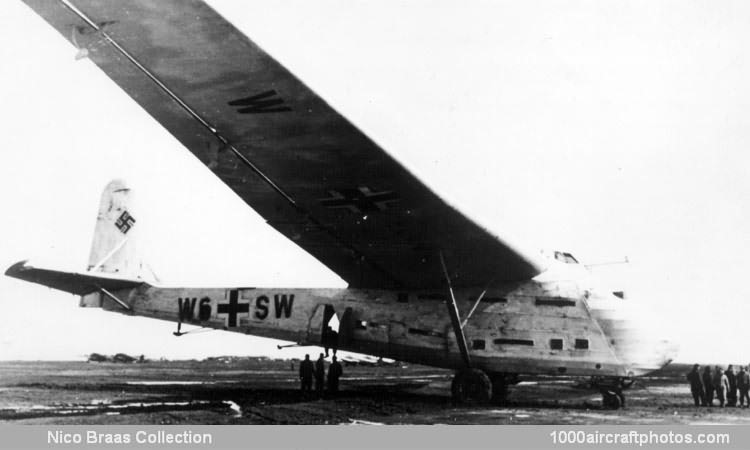The Gigant had a structure of welded steel tubing and wood with a mixed covering chiefly of fabric and wood. The rectangular-section fuselage was tall and cavernous at the forward section but, aft of the wing, tapered sharply towards the tail. Perched on top of the fuselage and on a level with the wing leading edge was the pilot's cabin, the fuselage nose sweeping down sharply in front of the cabin to permit a reasonable view. Loading was through large clamshell nose doors or through smaller doors on each side of the rear fuselage. The thick-section high-mounted wing was braced to the bottom of the fuselage and had a tapered planform, slight dihedral on the outer panels and auxiliary-wing type ailerons (similar to Junkers' designs) occupying most of the trailing edge.
There was a very tall fin, and the tail plane, which was braced above and below, carried an elevator in two halves, both elevators and rudder being dynamically balanced. Since the glider was of relatively light construction, the weight was spread over a multi-wheel bogie landing gear although these wheels were replaced in later Me 321 B models by two large-diameter wheels fitted to the fuselage at the point of the wing bracing attachment. Another change introduced with the Me 321 B was the increase in the crew from one to three and the fitting of four 0.311 in (7.9 mm) MG 15 machine guns. For all models, the payload could consist, for example, of either 48,510 lb (22,000 kg) of freight, a company of soldiers, an 3.56 in (88 mm) Flak gun, or a small tracked vehicle.
The Gigant was towed either by a single Junkers Ju 290 A-1, a trio of Messerschmitt Bf 110 Cs (known as a Troika-Schlepp, troika tow) or, ideally, by a single Heinkel He 111 Z Zwilling (Twin). Such towing power was not always sufficient on bad terrain when the glider was fully loaded, and ATO (assisted take off) units could be fitted in the following combinations of Walter rocket units which were jettisoned after use and recovered by parachute: eight 109-500s (e.g. on Me 321 A-1) each giving 1,102 lb (500 kg) thrust for 30 sec, four 109-501s each giving 2,205 lb (1,000 kg) thrust for 42.5 sec, or four 109-502s each giving 3,307 lb (1,500 kg) thrust for 30 sec. There were also various schemes, some of which were tested only, for fitting multiple arrangements of Argus 109-014 pulse-jets, of the type employed in the Fieseler Fi 103 V1 flying bomb, intended to extend the range of the glider once released from its tow.
In May 1941, the first Luftwaffe unit received the Gigant. This was the Grossraumlastensegler (large-capacity transport glider) unit Me 321 based at Leipheim and commanded by Fritz Morzik. The unit comprised three Staffeln (squadrons) of six Me 321 A-1s and a Motorstaffel with four trios of Bf 110 Cs for towing. Ferrying material during the proposed invasion of the UK was probably set as one of this unit's duties, but it was disbanded in December 1941. The principal work of the Gigant then became ferrying material to the Eastern Front. Another unit known to have used the Me 321 A-1 (e.g. W6+SW) was the Grossraumlastensegler-Kommando 2 (abbreviated to (GS)Kd02), which was based at Obertraubling in January 1943 and used He 111 Z towing aircraft. Altogether, about 200 Me 321s were built at the Messerschmitt Leipheim and Obertraubling (Regensburg) factories, and in France."
The following data relate to the Me 321 B-1.
